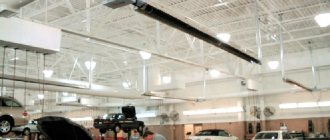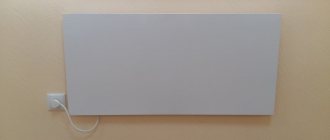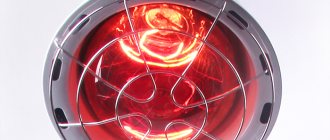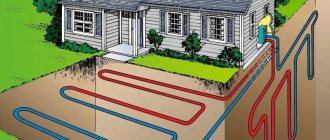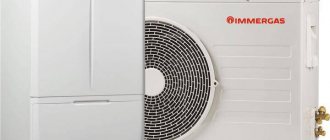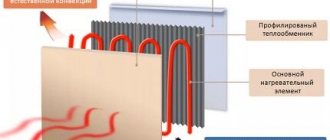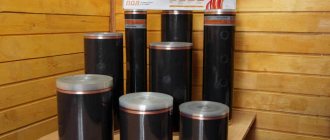Home » Central heating » Infrared
Large industrial sites are difficult to heat in winter. No standard heating system can simultaneously heat a building efficiently and evenly, have a beneficial effect on worker health, and also be economical. The only exception is industrial infrared heating. The design of an industrial device has specific differences from its household counterparts. All professional heaters are divided into several types, it all depends on the heating source and design characteristics.
Industrial infrared heating
What are industrial-type IR heaters?
Infrared heaters for heating workshops and warehouses use gas, electricity or other fuel to obtain an initial source of energy with its further transformation into infrared radiation. The device has a simple and reliable design:
- metal case with heat-resistant coating;
- sealed container with heating element;
- aluminum reflector.
Warming up production work areas with infrared heaters costs less than standard heating using a radiator system. The warmth in the room is felt immediately after turning on the equipment. Infrared radiation affects the surface of objects, heating them. The remaining heat is transferred to the air using natural air exchange. The method of operation of the heater is somewhat reminiscent of heating the earth and the influence of the natural heat carrier - the Sun. In winter, under the direct rays of the sun, a person feels hot outside, even when it’s freezing. This happens due to exposure to ultraviolet radiation. A similar method is the basis of IR heating systems.
Operating principle
The basis for the operation of an industrial infrared heater is IR radiation sources. The principle of their operation is as follows:
- Infrared emitters are connected to the electrical network and begin to generate IR radiation (or generate it due to the combustion of natural or liquefied gas), and in fairly large volumes - it is important to take into account the size of industrial-type premises.
- Infrared rays hit surrounding objects (walls, floors, ceilings, furniture, etc.), as a result of which they begin to release thermal energy.
- Heated objects, in turn, release heat into the air, which contributes to a comfortable temperature in industrial premises.
IR gas heater
Gas-powered infrared heating systems have many advantages that attract potential buyers. The main advantage of use is considered to be the high efficiency of the device. If we compare it with other systems operating on gas, then fuel consumption in IR is 80% less. Provided that infrared is actively used, industrial heating equipment pays for itself within two seasons.
Gas infrared heater
pros
The undoubted advantages of infrared heaters are:
- excellent level of heat transfer with low heat or electric current consumption;
- a wide variety of appearance depending on the designers’ intentions;
- "soft warmth";
- maintaining normal air humidity;
- no smell of burning dust;
- relatively small area of the device;
- no need to store fuel reserves;
- almost complete absence of noise;
- ability to connect to a regular electrical outlet;
- mobility of technology.
But it is necessary to understand the positive aspects correctly - that is, not as absolute advantages. Thus, the efficiency of infrared heaters is manifested only with a competent approach. A lot depends on the correct selection of materials for the house and good thermal insulation. If mistakes are made in these moments, the efficiency of heating devices will not correct the situation. By the way, it is only slightly higher than the efficiency of conventional electric convectors.
Types of IR gas heaters
Infrared ceiling electric heaters for production sites are divided into two groups:
- light emitters - designed for heating factories with a ceiling height of at least 4 meters. Such models are one of the most productive and powerful in their segment. Thermal power calculation is carried out taking into account that for every 20 cubic meters a power installation of 1 kW is required. 5 kW mounted heaters will quickly cope with heating 100 cubic meters. The method of operation of the device is to absorb a gas mixture and air in a special burner at a temperature of 800-1000 degrees. A gas outlet channel is used to eliminate combustion products;
- dark emitters - the process of gas absorption is carried out at a temperature of 350-400 degrees. As a result, the metal tube, which is the emitter, does not glow red-hot, which contributed to the reason for the name of the heating devices. When fixing heaters of this type, you need to take into account that the emitters are larger in size than their light-colored counterparts. For factories and workshops, light or dark type devices are chosen. The choice depends on the technical characteristics of the building itself and the type of production activity.
We recommend: Types of infrared heating panels
How to make a gas infrared heater for a garage with your own hands
Not every user is ready to shell out their hard-earned money to purchase a small heater, which will greatly simplify the life of a car owner in his own garage during the cold season. Of course, after all, independent car maintenance, as well as its repair, require at least relative comfort.
In rare garages, heating was initially planned, which is why something has to be thought out later, closer to winter, as a rule.
Not every car enthusiast, as already mentioned, wants to spend money on an expensive device that will be used occasionally, and many car owners in our country are real “handicraftsmen”. Fortunately, in my own garage there are tools and some materials that are kept in it “just in case” - that is, they have hypothetical value.
So, there are handicraft “developments” for this case that allow you to solve this serious issue.
Before manufacturing such a device, you need to understand the principle of its operation, as well as become familiar with the production and assembly procedures.
The most necessary qualities of the device:
- Easy to activate.
- Sufficient power to quickly warm up the box.
- Simple design with minimal costs.
- Device security.
Whatever heating method is used in the garage, in most cases ventilation is necessary. This is necessary because with any heating either the amount of oxygen decreases or combustion products accumulate in the air, which is a risk to human health and life.
Preparation of materials and finished parts for the production of a garage heater comes down to what you need to prepare:
- You need to purchase (if not available) a burner with a valve.
- Sheet of tin.
- Scissors for cutting metal.
- Drill and set of drills.
- Rivets with a riveter.
- Fine mesh steel mesh to make a lattice. It can be replaced by an old mesh small-sized colander.
- Collet cylinders. Their convenience lies in the fact that the contents cannot be consumed all at once due to shut-off valves. As an option, it is not necessary to use cylinders for gas lighters, but a small country cylinder, for example.
Manufacturing itself:
- The heater must be fixed to the burner. To do this, you need to draw protruding ears on four sides, one of which will be twice as long as the other three.
- The blank is cut along the intended contour. Carefully cutting with metal scissors, excess material is put aside as unnecessary.
- The burner must be screwed to the workpiece using bolts.
- The ears are bent in the other direction and are used to secure the mesh.
- The strainer, already fixed, is initially made in the shape of a dome - this will allow the heat to be evenly distributed to the sides.
- To secure the second mesh, another sheet of tin is taken, and a circle of the same size with the same ears for attaching the mesh is cut out in it.
- Stepping back from the edge 5 mm. 10 holes are drilled in a circle - they will serve as a nozzle for the flame.
- A strip of length equal to the diameter of the already made tin blank is cut out of a piece of fine mesh.
- The ears are bent on all sides, using mesh strips to fix them, while the second workpiece is fixed on the opposite side.
- The round shaped ears of the blanks (already bent) are attached to the opposite ends of the strip by means of rivets using a rivet gun.
When already assembled, the structure is a kind of cylinder with walls made of mesh and ends made of tin.
The two mesh design is advantageous in that the heating surface is increased and has additional protection.
Now all that remains is to turn on this heater and test it in action. The heat will be enough to heat a garage or even a small room.
Advantages of gas emitters
Experience in using gas emitters has made it possible to discover several key advantages that set the equipment apart from its analogues:
- possibility of local heating of the room;
- reduction of heat consumption;
- payback in a short time;
- no costs for maintaining boiler house workers;
- the ability to turn off the device in winter and instantly warm up the unheated area if necessary.
The technical characteristics of industrial infrared heaters do not allow their use at home. The minimum ceiling height of the room required for safe use is from 3 to 4 meters.
Conclusion
Electrical equipment is more expensive than gas equipment if you use main gas fuel.
Dark units are heavier in weight and should be mounted on special brackets or hanging mounts, while light IR units are much lighter. Without preliminary calculations, it will be extremely difficult to arrange such a system so that it works optimally. It will be necessary to take into account the parameters of the room, special production conditions, the use of heaters, as well as their characteristics. If the heating area for which the device is designed is small, you should simply install several of the same ones. Date: September 25, 2022
Types of electric infrared heating systems
All emitters can be divided into several groups according to the following characteristics:
Depending on the type of fixation, the emitters can be mounted on the ceiling or wall. There are universal devices and floor systems. Stationary and mobile installations are also used, which are in demand among construction teams. The use of wall-mounted infrared heating systems is limited by the fact that furniture and flammable objects cannot be installed near the heating source. By type of work, there are emitters that produce short and long infrared waves.
Short-wave systems are used for drying wood and paint block apparatus. The effect of short IR waves on humans is extremely toxic, therefore installation of such heaters in a room with a constant crowd of people is prohibited. Long-wave emitters have a positive effect on human health, which is why they are used at production sites. Long-wave heaters are effectively used as main heating in winter.
Long wave infrared heaters
Victoria Vranska, executive director of ADRIAN Group sro
The role of infrared heaters in the heating market
Heating using infrared radiation has not been a novelty for a long time, but world practice still does not know a more effective way to ensure the thermal regime of an enterprise at a price three to four times lower than the cost of traditional boiler houses. Not only the operating costs, but also the investment for the purchase and installation of radiant gas heating is significantly lower than the cost of building a boiler house. This attracts investors and puts such a system in first place in the segment of heating industrial premises.
The popularity of infrared heaters
The popularity of infrared heaters is growing day by day, as against the backdrop of rising energy prices, more and more positive reviews are appearing about the energy-saving properties and efficiency of this product. There are still a lot of existing facilities that are ideally suited for gas radiant heating. And new ones are being built. And winter, despite global warming, has not been canceled.
Who are the consumers?
Gas-radiant heating is an ideal choice for owners of industrial facilities, since when heating large premises it is the single most energy-efficient solution. And - an unacceptable option for use in rooms with a ceiling height of less than 3.5 meters, since investments in equipment are not effective enough compared to the amount of energy savings for a small room. Any gas-using equipment cannot be used indoors with a fire or explosive environment. Also, such infrared equipment is not suitable for heating food warehouses, since the physical principle itself involves the formation of heat on the surface of solid objects and bodies.
About technical specifications
The technical characteristics of devices of the type in question comply with increasingly stringent standards and regulations. For example, new European Energy-related Products (ErP) standards came into force last year. The annual audit of certification bodies is aimed primarily at safety and verification of compliance with these standards.
Infrared heaters: modern control
Smart control systems for infrared heating have been modernized, which has improved their energy efficiency. Very often, in addition to gas radiant heating, other equipment is installed at the facility. For example, door curtains for large gates, destratifiers for recovering heat from the under-ceiling space, hot-air systems for providing ventilation, etc. The whole complex should work as a coherent mechanism for the benefit of the consumer. For this purpose, dispatch systems are used, which make it possible, in addition to remote access, to analyze the results of work and optimize it. For small facilities whose owners also want to control temperature conditions remotely, inexpensive control systems are available using a mobile application on a smartphone.
About competition
There are no new serious brands emerging. Some companies of American origin left the market due to counter-sanctions, as well as firms for their own internal reasons (for example, they were unable to survive a number of crises in recent years, lost key dealers in the market, etc.).
About prices
The price of equipment for gas radiant heating in euro equivalent has remained virtually unchanged. However, after the shock of 2014–2015, when prices for equipment in rubles suddenly almost doubled, the market seemed to get used to it, and everyone realized that there was no turning back. That is, we had to adapt to the current situation. The price of the equipment itself is no more than half of the customer’s total costs. And prices for design services and construction and installation work are rising along with energy prices and inflation.
About device durability
First of all, the service life is affected by the quality of the source materials and the quality of production at the manufacturer. Undoubtedly, polished stainless steel in the standard version will perform its function of reflecting infrared waves much longer. The same goes for all key components. 100% commissioning at the bench and technical control at the output, before sending the product to the customer, reduce the possible risk even if the field installers do not comply with the regulations during startup. The ease of handling IR heaters often “relaxes” the customer—“set it and forget it.” At the same time, they forget about the requirement for mandatory maintenance before each heating season, personnel training, etc. Correct installation and the level of regular qualified maintenance are integral components of long-term and proper operation of the equipment.
About fire safety
In my memory (25 years of experience) there were no precedents of fire due to malfunction of infrared burners. The cause of any fire or other disaster is always the human factor. All examples are known and understandable. The fire safety of devices is ensured, first of all, by the correct choice of room category, as well as by various technical safety features inherent in the design of any gas-consuming equipment.
Counterfeit
I personally am not aware of any cases of counterfeit products in this segment. We probably need to raise some customs statistics. Counterfeiting implies illegal imports without customs duties, so we assume that the fight is being waged by the state itself. This question most likely relates to the categories of small, easily sold equipment for general consumption. Infrared heating systems are not one of these.
The place of infrared heaters in the heating market
Infrared heating, due to the special physics of energy exchange, is theoretically considered one of the most energy-efficient heating methods. But practice has shown that this is the most economical way to spend energy resources used for heating needs, be it gas, electricity or superheated water. From the point of view of engineering and economic calculations, we note that this saving is higher, the greater the difference between the air temperature and the radiation temperature of the room or space. Don’t be scared - in this case this is not a term from nuclear physics, the key word here is “ray”, heat ray. All space, having received heat, as from the Sun, heats up and re-radiates heat into space. Radiation of heat from a source occurs in all directions, therefore any radiation, including thermal radiation, is called radiation. As a result of this thermal radiation (radiation of heat from heated objects), the perceived temperature is higher than the air temperature. This is savings - the target actual air temperature is lower than the perceived one, as on a sunny day. Therefore, energy consumption with such heating is always less than with convectors and other systems where the air is heated directly. And especially this type of heating is most economical in rooms with high ceilings.
In terms of efficiency, only warm floors can compare with infrared heating. But this is also a type of IR heating, only the source is under your feet, and not on the ceiling, like a classic IR device. A warm floor is also an infrared source, but only at a very low intensity, for obvious reasons - the floor temperature should be comfortable. In terms of price attractiveness of cost and installation, IR heating is also quite competitive. Instead of an extensive system for transporting coolant (as with convector, radiator or floor water heating), we hang the device directly in the room and supply the energy carrier (gas or electricity) to it. This is a decentralized type of heating, without installing a heat transportation system. Both installation and operation of such systems are cheaper in terms of the entire life cycle cost (Life-Cycle Costing, LCC), which includes cost, installation and energy consumption. In a word, infrared heating is beneficial in all respects.
The popularity of infrared heaters
The popularity of infrared heaters is growing today, but not as quickly as the first suppliers of these heating systems planned. When it comes to gas infrared heating systems, those who use them after upgrading old systems will never give them up because of the proven savings. But those who want or plan to use them have design difficulties. This applies to industrial and agricultural areas. The stumbling block is the fire hazard class of the premises. Until now, both designers and supervisory authorities use the old SNiPs. Few people know and use the ABOK standard for the application and design of such systems, and yet it was released on November 30, 2006.
The second problem, which concerns all types of infrared heating devices, is correct calculation and design. This type of heating was discredited by consumers due to the incompetence of everyone responsible for selection and calculations. Basically, this is the wrong choice of heating intensity. Since this is a different physics of energy exchange, then the calculation of power is different. In practice, the power of such a system should be less than the generally accepted design one, taking into account the intensity of the heat flow. As a rule, the installed power is 10–20% lower than the standard calculated one (the exact percentage depends on the type of device - the higher the intensity, the lower the installed power). As a result of the incorrect choice of the type of devices and incorrect calculation of their power, in places where people constantly stay, the temperature of heated areas exceeds that of comfortable ones.
That is, in simple terms, there is a risk of getting “heatstroke”. This type of heating requires more careful consideration when choosing and calculating, but due to proven operating savings, the popularity of infrared heaters is growing.
Who are the consumers?
The main consumer of gas infrared heating systems is an industrialist, a manufacturer of agricultural products and the owner of logistics or warehouse complexes. The higher and more extensive the structure, the more economically profitable it is to use infrared heating if gas is available. Gas infrared heaters are completely unsuitable for use in domestic premises with low altitudes. The minimum gas infrared device has a power in the range of 9–15 kW from different manufacturers, this determines their application limitation: the minimum suspension height is 3.5 meters for an area of at least 60–80 m².
The consumer of electric infrared heaters, due to their small unit power (from 500 W), can be anyone in need who can use electricity for heating. There are no restrictions here (except perhaps for explosion safety reasons). Evenly place the required number of heaters on the ceiling, connect them through a thermostat (simple bimetallic or electronic) - and that’s it.
There are also low-intensity infrared ceiling panels that use hot or superheated water to heat the radiant panel. They are universal in their field of application, but very expensive, both structurally and in installation. They require a hot water boiler with a pipe system under higher than standard pressure, since the water temperature in them is 100–115°C. It is clear that increased attention is also required for crimping the pipe system. But they have an additional benefit that no other infrared heating system has. In the summer, they can serve to remove excess heat from the room - a kind of air conditioner, only silent and without air movement. If instead of hot water the system is filled with refrigerant, then, taking on heat, the panels work like evaporators in an air conditioning system in conjunction with a compressor-condensing unit.
About technical specifications
In recent years, all leading manufacturers (who could afford it) have tried, first of all, to improve technical characteristics. But basically everyone worked on reducing production costs without losing the overall radiant efficiency of the device. And primarily due to the accompanying component base of auxiliary instrument units. Many manufacturers of gas infrared devices have found cheaper automatic components for gas burners and smoke exhaust or blower fans (some at the expense of service life). So manufacturers of this type of heaters have reduced costs without reducing technical characteristics. And this is also an achievement. Well, the service life can be extended by expanding the maintenance schedule and doing it more often. Some have improved the comfort of heat flow through research in materials science. The main characteristics of IR heaters are emissive and reflective abilities, which have been worked on. For example, Roberts-Gordon and Norgas used aluminization of the first pipe adjacent to the burner.
It must be said that the first pipe from the burner is the hottest place of the emitter with the highest intensity (very noticeable discomfort at low altitudes). Thanks to this, the radiation of the first pipe was reduced and heat transfer in the last pipes was increased, which led to uniform heat flow along the entire length of the emitter. A specially shaped swirler was installed in the last pipe in front of the smoke exhauster, which made it possible to swirl the flow of hot gases to uniformly heat the entire radiating pipe (the length of one module is 6–12 m). Reducing the emissivity of the first pipe and installing a swirler in the last pipe led to the fact that the first pipe became less hot, and the thermal field of the emitter along its entire length became more uniform. It is difficult to determine whether this “tuning” has affected its popularity. It certainly had an effect on those who are experts in such systems. It is appropriate to note here that there are more knowledgeable people, but not every potential customer tries to dive so deeply into the technical subtleties that distinguish one brand from another.
Infrared heaters: modern control
Even the basic initial version of infrared heater control included full automation with multi-zone control. The controller allows you to accurately maintain the target temperature in each tracking zone with hourly programming and nightly reduction. And for many years there has been a GSM controller that allows you to control the entire system remotely at any distance. You can limit yourself to a controller for an isolated internal network, the so-called Ethernet controller. This is suitable for a plant-wide dispatch system from a factory control panel.
The current position in the market of remote control systems allows you to automate processes of any complexity in any network architecture and manage these processes as remotely as the customer wants.
About competition
Competition within a free (non-monopolized) market economy always increases. This is the law - new suppliers and manufacturers are appearing. As always, Chinese manufacturers are ahead of all others in the speed at which new models enter the market. But simply copying already good IR systems does not mean that all specifications will be met. Old companies, step by step, working in laboratories, improved primarily the quality of the main components - mainly emitting and reflecting components. And often the developments in the materials science of these units are the companies’ know-how. Simply copying the shape and having a rough idea of what metal is used is not a guarantee that it will be a similar device.
There are several companies in Russia producing gas IR systems that use production lines from European manufacturers. But we must understand that these production lines appeared here as a result of decommissioning after modernization there. Naturally, now these companies are modernizing something in production technology. Two more completely new Russian manufacturers of gas infrared systems have appeared, which have good technical characteristics. We won’t voice their names - an Internet search engine will show you.
Regarding electric infrared heaters, there are even more manufacturers than industrial gas IR systems. The competition is fierce. But the criteria for competitiveness again lie in the ratio “price - quality - life cycle cost” (including energy and maintenance costs for the entire service life).
About prices
I don’t remember a period of time when there was a decrease or at least long-term stabilization of prices (if you don’t delve into the old days, when they didn’t even know about infrared systems). The answer here is very simple. If these are imported systems, then the price depends on the exchange rate of the supplier country. If the assembly is Russian, but there are some imported components, then the price is less dependent on the exchange rate and for a long time can be indexed only with inflation. Economic disturbances associated with economic sanctions force us to look for workarounds that also add value.
About device durability
If we do not touch upon errors and shortcomings in operation and maintenance, then all factors of durability lie in the quality of materials and components of the systems themselves. If we talk about gas infrared heaters, their design is quite complex, and within the framework of a simple answer it is impossible to talk in detail about all the factors. But the quality of materials and components of the main components can be determined even visually. As A. N. Tupolev said: “Only beautiful airplanes can fly well.” A good and reliable unit looks like a complete and beautiful engineering creation. If a unit that is reliable in terms of technical characteristics is selected, then the next most important factor in durability is simple compliance with the maintenance regulations recommended by the manufacturer. By the way, the cost of maintenance along with consumables is included in the life cycle cost. Therefore, life cycle cost is the best engineering and economic criterion when selecting a supplier. The same criterion will meet all factors of the durability of the unit and the system as a whole.
About fire safety
A preventive fire safety system is included in any modern device. For example, the electric convector has a built-in bimetallic overheat shutdown thermostat, which is installed directly on the body of the heater - convector. A simple test shows that it works almost flawlessly. If, even by accident, the blinds of the electric convector at the outlet of warm air are closed by something (for example, a fallen curtain), then the safety thermostat is activated when the internal temperature of the housing does not exceed +90°C. In any case, this is below the temperature of the most easily flammable material. And fires generally occur not due to the fault of the electric convector, but rather due to overheating of old wiring or due to high contact resistance in electrical connections. For a fire to occur from a convector, you must specifically throw something highly flammable inside the heater, directly onto the heating element or coil. But this can also be caused by the accumulation of flammable dust on the heater (flour or sugar suspension, for example).
Gas systems have even more fire safety requirements and preventive devices provided by the manufacturer. The safety devices in these systems duplicate each other, and there is often even multi-stage protection. For example, the gas valve is designed to operate within maximum and minimum pressure limits; in the absence of gas, the burner igniter does not ignite; the ionization sensor protects against interruption of the burner flame - in case the smoke exhaust fan fails. And, in addition, after one of the protective devices is triggered, the blocking can only be removed manually. This ensures that the fault is corrected before restarting.
Counterfeit
We have been working with the same equipment manufacturers for a long time. And these are famous brands. Therefore, we personally, as an engineering company that also supplies equipment, have not encountered any experience with counterfeit products. But we assume that there is enough counterfeit in the infrared heater market to declare this as a serious problem.
Advantages and disadvantages of electric heaters
Many people cannot get enough of infrared heaters due to their striking advantages:
- ideal for working in dusty and dirty rooms, as well as for buildings with a high level of fire hazard;
- the possibility of use not only as a general and partial heating system, but also as special equipment for drying;
- a spot heater is used in paint and varnish production, for heating steel before processing, and arranging an anti-icing system for the floor;
- Electric heaters are actively used in educational and medical institutions.
We recommend: Advantages of heating with infrared heaters
The downside is the high price of electricity. You can slightly reduce heating costs by installing industrial temperature sensors.
Buyer mistakes
When choosing products, buyers make the mistake of not paying attention to the thickness of the anodized coating of the heat-radiating plate, indicated in the accompanying documents. It becomes covered with a “web” of cracks with a thickness of less than 25 microns, and budget models with layer thicknesses of less than 15 microns last 2–3 years, turning into a regular stove after the layer burns out.
It is preferable to choose models with a protective mesh or screen if there is a possibility of subsequent contact with the electrical appliance by children and animals.
Infrared household appliances have undeniable competitive advantages. While oil radiators and convectors heat up after being plugged in after 30 minutes, the thermal effect from infrared units is felt almost instantly. Despite the higher cost compared to analogues, infrared product items will be a profitable purchase for those buyers who value high efficiency, directivity and speed of heating, and quiet operation.
Popular models of industrial IR heaters
On the heating systems market you can find a huge number of different models of radiators operating on gas and electricity. Proven Russian manufacturers of thermal devices:
- IcoLine;
- Peony;
- EcoLine;
- Mr. Heath;
- Infra.
As users note, good mobile and stationary heating systems are offered by the Pion company. Before buying, make sure that this is not a Chinese counterfeit. The service life of the Peony emitter of the latest models is much longer due to the improved quality of the aluminum reflector. The maximum heating area of one installation is 80-100 cubic meters. Among the foreign manufacturers of infrared heating systems for industry, the following can be distinguished:
- Helios;
- Hyundai;
- Zilion;
- Starprogetti.
Automatic electrical IR systems for industry are distinguished by practicality, high power, quality, long service life and safety, if you choose South Korean and European manufacturers: Siemens, ABB, Du Pont.
Are IR heaters harmful to industry?
Air heating of workshops and factories using infrared gas and electric types, provided that the system is correctly selected and recommendations are followed, is completely safe for people and the environment. Short-wave emitters can cause harm to humans. It is also necessary to strictly observe the proper installation of IR systems in the production area. Usually the manufacturer marks a dangerous installation location. If all safety requirements are met, IRs are considered safe and have a positive effect on humans. In terms of their technical parameters, IR emitters have no analogues.
YouTube responded with an error: The request cannot be completed because you have exceeded your quota.
- Related Posts
- Features of infrared plasterboard heating
- Is there any health risk from infrared heating at home?
- What are the pros and cons of infrared heating?
- Advantages of heating with infrared heaters
- Types of infrared heating panels
- How to install infrared ceiling heating?
The essence of infrared radiation
Infrared radiation differs from ordinary and so familiar visible light. They are similar in the speed with which they spread and cross space. Both varieties are capable of refraction, reflection and bunching.
Unlike ordinary light radiation, which is electromagnetic waves, IR flux has both wave and quantum properties. That is, it transmits both light and heat.
Both ordinary light and infrared radiation are streams of electromagnetic waves. The difference is that in the first case the visible component predominates, in the second the visible component is combined with the thermal
The light supplied by infrared devices moves in waves. Electromagnetic light vibrations are in the spectrum segment from 760 nm (nanometers) to 540 μm (micrometers). The heat generated by IR emitters is a flux of quanta. Their energy ranges from 0.0125 to 1.25 eV (electron volts).
The heat and light fluxes emitted by infrared devices are interconnected. As light intensity increases, the quantum heat flux decreases. Depending on the temperature, infrared radiation may or may not be perceived by our eyes. Thermal radiation is not visually detectable.
This specificity of infrared radiation is used in industry to accelerate polymerization and hardening processes. The thermal part of infrared radiation makes it possible to determine the presence and location of a person or animal in dimly lit and unlit night periods.
Infrared heating devices emit light in combination with thermal energy, used to create a comfortable microclimate on parking lots, workshops, production halls, poultry farms, greenhouses and many other objects
The non-standard operation of IR devices that emit light in combination with heat became the basis for the development of night vision devices. It is used in flaw detection, in hidden alarm systems and in technical devices for photography in the dark.
Both components of infrared radiation are almost not scattered in the treated space; they seem to be focused on objects located in the zone of their influence. Heat penetrates into the body of the heated object, the depth of penetration depends on the properties, structure and material of the object. The depth varies from a tenth of a mm to several mm.
Infrared heaters are installed on the floor, attached to walls, or suspended from the ceiling. The devices are distinguished by flameless combustion, preservation of oxygen in the surrounding space, and do not raise columns of dust, unlike convectors
When used for industrial purposes, the wavelength from infrared emitters is selected based on the technical characteristics of the object or substance. IR rays pass freely through the air mass, so heating is carried out without noticeable losses. This circumstance is reasonably considered a significant advantage in production.
In addition to heating and illuminating the area treated by the device, infrared emitters are used to solve the following problems:

